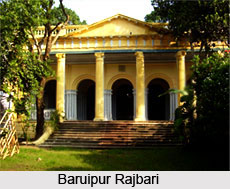 Baruipur is a city as well as a municipality located in the South 24 Parganas district in the state of West Bengal in India. It is at a distance of 25 km from the Sealdah Railway Station.
Baruipur is a city as well as a municipality located in the South 24 Parganas district in the state of West Bengal in India. It is at a distance of 25 km from the Sealdah Railway Station.
Location of Baruipur
The exact geographical location of Baruipur is at 22.35 degree North and 88.44 degree East. It has a mean elevation of 9 metres (29 feet).
Demography of Baruipur
As per the 2001 population census of India, the suburb city of Baruipur has a population of 44,964. The males make up 51 percent of the population and females constitute 49 percent. Baruipur has a mean literacy rate of 84 percent, higher than the nationwide standard of 59.5 percent. 52 percent of the males and 48 percent of the females are literate. 8 percent of the population is children less than 6 years of age.
Administration of Baruipur
Baruipur is administered under the District Headquarters of South 24 Parganas. And the South 24 Parganas is under the headquarters of Alipore District Management. It has the metropolitan city of Kolkata on one side and the remote riverine villages in the Sundarbans Mangroves Forest Region.
Culture of Baruipur
Baruipur is famous for the Gajan Utsab during the time of Poila Baishak. As a certain legend goes, there was once a severe `lathi` fight between the lathials of the Sabarna Choudhurys of Barisa and the Roy Choudhurys of Baruipur pertaining to the boundary disputes of their respective Zamindaris. The head of the lathials of Sabarna Roy Choudhury was Bhriguram. The lathials of Baruipur managed to decapitate him with a sword and won the battle. Nevertheless, Bhriguram was so much esteemed in the region that a lock of his hair was preserved. People still honour Bhriguram in public by displaying the preserved lock during the Gajan Mela at Baruipur.
Economy of Baruipur
The economy of Baruipur is dependant on the flourishing surgical tools industry, which is now on revival path. Baruipur is also famous for guava plantation. The people of the South 24 Parganas district are mostly engaged in agriculture, industry and pisciculture.
Visiting Information
Baruipur is easily connected with the railways and roadways. The trains from Sealdah and the bus routes from different parts of Kolkata intersect Baruipur.



















